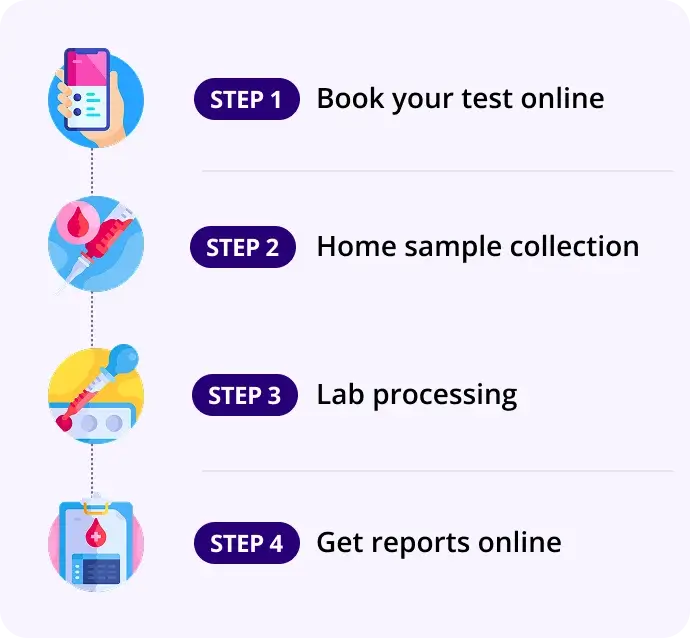Body fluid analysis for malignant cells
Report in 78Hrs
At Home
No Fasting Required
Details
To detect: Presence of cancerous (malignant) cells, The type of cancer (adenocarcinoma, lymphoma, etc.), Whether the malignancy is primary or metastatic
₹490₹1200
59% OFF
🧪 Body Fluid Cytology – Malignant Cell Detection
Parameter | Details |
|---|---|
Test Name | Cytological Examination for Malignant Cells in Body Fluids |
Sample Type | Pleural, Ascitic, Pericardial, Synovial, or CSF fluid |
Fasting Required | ❌ Not required |
Organs Involved | Lungs, abdomen, heart, brain, or cancer metastasis sites |
Purpose | Detect or rule out malignancy (cancer) in body cavity fluids |
🧬 What Is This Test?
This is a microscopic examination of fluids collected from various body cavities (like chest, abdomen, or pericardium) to detect:
- Presence of cancerous (malignant) cells
- The type of cancer (adenocarcinoma, lymphoma, etc.)
- Whether the malignancy is primary or metastatic
🔬 Fluids Commonly Examined for Malignancy
Fluid Type | Associated Body Region | Common Related Cancers |
|---|---|---|
Pleural Fluid | Lungs | Lung, breast, lymphoma, metastatic cancers |
Ascitic Fluid | Abdomen/peritoneum | Ovarian, GI, pancreatic, breast, gastric cancers |
Pericardial Fluid | Heart cavity | Lung, breast, lymphoma |
CSF | Brain/spine | Leukemia, lymphoma, metastatic brain cancer |
Synovial Fluid | Joints | Rare, can be involved in leukemia or metastasis |
🧪 How Is It Performed?
- Sample Collection – via paracentesis, thoracentesis, or lumbar puncture
- Centrifugation – to concentrate the cells
- Staining – using Papanicolaou (Pap) or Giemsa stains
- Microscopic Evaluation – performed by a pathologist or cytologist
🧠 What Does the Test Look For?
Feature | Implication |
|---|---|
Cellular atypia | Suggests malignancy |
High nucleus-to-cytoplasm ratio | Common in cancer cells |
Irregular nuclear contours | Suggests aggressive growth |
Mitotic figures | Active cell division (tumor activity) |
Clustering of cells | Characteristic of adenocarcinomas |
⚠️ Clinical Indications for Malignant Cell Testing in Fluids
- Unexplained pleural, pericardial, or ascitic effusion
- History of cancer
- New-onset effusion with weight loss, fever, or lymphadenopathy
- Abnormal imaging (e.g., peritoneal thickening, lung mass)
💉 Additional/Conjoint Tests Recommended
Test | Purpose |
|---|---|
Tumor Markers (CEA, CA-125, CA19-9) | Support diagnosis, identify primary cancer |
ADA (in ascitic or pleural fluid) | To rule out TB as an alternative cause |
Flow Cytometry (for lymphomas) | Detect monoclonal B/T-cell populations |
Immunocytochemistry | Identify tumor type origin |
Molecular Testing (EGFR, ALK, KRAS) | In lung cancer diagnosis from pleural fluid |
TB PCR / AFB Stain | Rule out tuberculosis (especially in high TB zones) |
Serum LDH & Fluid LDH/Glucose | Differentiate exudate vs transudate |
Radiology – CT/MRI/Ultrasound | Detect primary mass, nodules, metastases |
🧭 Interpretation Guide
Result | Implication |
|---|---|
Malignant cells present | Positive for cancer spread or primary body cavity cancer |
Atypical cells present | Suspicious – may require repeat test or biopsy |
Negative for malignancy | Does not entirely rule out cancer; may require follow-up |
📌 Summary Table
Test Name | Body Fluid Cytology (for Malignancy) |
|---|---|
Sample Required | Body cavity fluid (pleural, peritoneal, etc.) |
Purpose | Detect or rule out malignancy in effusions |
Supports Diagnosis Of | Lung, GI, ovarian, breast, hematologic cancers |
Needs Correlation With | Tumor markers, Imaging, Biopsy, Immunostains |
How our test process works!

